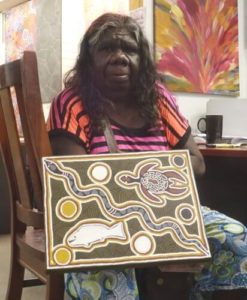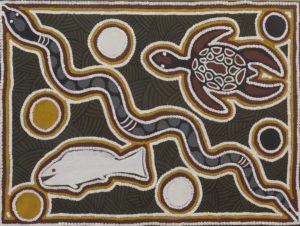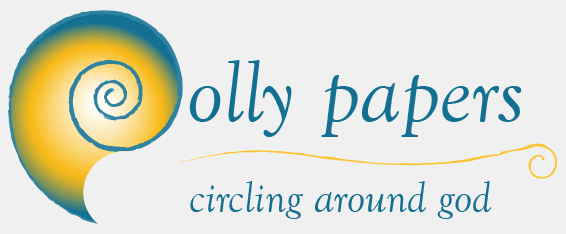 Centuries ago, a wise prophet and a dreamer observed that without a vision, the people will perish.
Centuries ago, a wise prophet and a dreamer observed that without a vision, the people will perish.
My daughter moved to Australia in 2001. Over the course of several visits with her, I would learn a bit more about the history and traditions of the country, particularly those of the indigenous peoples, the Aborigines, who retain to a remarkable degree the characteristics of the earliest humans. The concept of private property was unknown in aboriginal society. There were no settlements: they were nomadic people who walked the land in annual migration, finding shelter and sustenance as they went. Often, their journeys would be prompted by a spirit messenger calling them to travel.
In Aboriginal myth, the Earth’s surface once was nothing but a vast, nondescript expanse of mud or clay. But that lifeless landscape changed when ancestral spirit beings rose from beneath the surface or descended from the sky and assumed the forms of animals, plants, and humans. These spirits journeyed across the Earth, changing it by shaping the mud into rivers, hills, islands, and other features. They gave birth also to all living things—including humans, to whom they also gave languages, knowledge, and beliefs. When aboriginal people walk the land now, they go with the understanding that they walk these ancient paths first traveled by their ancestral spirits. Although sometimes called simply “walkabouts”, the purpose of the walking is to recreate the world.
These are the songlines, by which they enter a mystical realm called Dreamtime or the Dreaming. The Dreaming is that sacred era in which their ancestor Spirits formed The Creation. It’s a ritual for thanking the land and for sustaining their lives, while also believing that their footsteps send new life into the earth for another year.
The art of the Aboriginal people, like this piece by JuJu Wilson, represents the Dreaming with totemic animals belonging to family language groups, sometimes with songlines and waterholes and rivers associated with them.

In the 19th century, Europeans began to arrive; first as prisoners from England and later, people fleeing debt or dishonor, or adventurers and pioneers seeking a new start and a piece of land they could call their own. They began to divide up the sacred, life-giving land into ranches and towns. In so doing, they cut the songlines. There are stories of indigenous people dying on the spot when the songlines were severed. It was akin to cutting their arteries and spilling out the life blood of a nation.
And so the question: What is God? If I were to ask an indigenous Australian that question, she would have no answer since “God” is not a concept in her culture. But she might speak about The Dreaming in a way that resonates with other beliefs about the Holy One in that sacred time when the earth was formed, much like the Judaeo-Christian belief that, in the beginning, God created the land, the seas and all living things. She might answer that her walk along the songlines is similar to a call that all people keep the original vision alive with words and actions, just as it is recreated each season when she walks the songlines. And she might observe, with others from many traditions, that, when the earth is savaged and scoured for personal gain, the land begins to die as energy lifelines are severed. For the indigenous Australians, the Dreaming happens when travelers and ancestral spirit beings and earth energy are in harmony. As these three come together the vision is sustained and life continues on earth. In my own tradition, it’s akin to the belief that God exists as the Original Vision, as the Spirit of Christ calling us to carry out that vision which, in addition to caring for all God’s creatures, includes honoring and preserving the living earth. For me, that means there is nothing static about God: whatever name or with no name, it’s always in motion, always being renewed, and always in relationship with the land and the people.
Hold on to dreams/For if dreams die/Life is a broken wing’d bird/that cannot fly. (Langston Hughes)

I have been taking a break this summer and am now happy to welcome back all you faithful readers.
I want to thank everyone who has posted a comment over the last seven months since I launched this project.
Your words are gratifying and very helpful as I continue my circling around God. I appreciate your suggestions; please keep them coming.
May this next season prove to be a good one for all. Thank you!
Polly, a beautiful story. Thank you.
Good to hear from you, John. Hope all is well in the west…
Polly, that is beautiful! We recently hosted two charming “Aussies ” who were traveling around New England,
going between VBRO’s that had availablility. Their “dreamlines” took them from Montreal to Brattleboro Vt. to Fitzwilliam, Mass to Sandwich Mass. Not the typical tourist sites, but they wanted to connect with people and see smaller cities and towns. They were having wonderful experiences talking to “locals” and making connections.
Candy
Polly, this is such an appealing story. I like the concept of “Dreaming” as when people and animals and God are in non-static, always moving harmony. I’m forwarding it to my sister Sally, in Minneapolis, whose daughter, son-in-law and two granddaughters are living in Australia and presently have spent a month driving from Melbourne to Broome. Fabulous blog posts and pictures. Such a vibrantly different land!
Looking forward to seeing you both!
Lucinda
I love the Australian connections I’m seeing in yours and others comments. Thanks everybody for reading and replying!
Love this! Brings me back years ago to a fabulous journey I had in Australia, backpacking from Cairns to Brisbane and living out one of my dreams – learning to scuba dive! The Great Barrier Reef was like nothing I had ever experienced and remains etched in my memory even to this day. Thank you for sharing these insights about the folks who were there first!
Comments are closed.